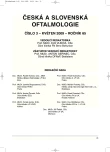Examination of the Acute Central Retinal Artery Occlusion (CRAO) by Means of Optical Coherence Tomography (OCT3)
Authors:
E. Mejzlíková; J. Novák; H. Adámková
Authors‘ workplace:
Oční oddělení Pardubické krajské nemocnice, a. s., a Fakulta zdravotnických studií Univerzity Pardubice, přednosta doc. MUDr. Jan Novák, CSc.
Published in:
Čes. a slov. Oftal., 65, 2009, No. 3, p. 75-78
Overview
Purpose:
Ischemic edema of the retina develops after CRAO and a regressive phase follows usually without any possibility of objectification. The aim of the study is to determine dynamics of edematous changes in the central retina using the OCT (Optical Coherence Tomography).
Setting:
Department of Ophthalmology, Regional Hospital in Pardubice, Czech Republic, E.U.
Methods:
During the period between June 2004 and January 2005, ten patients with the diagnosis of CRAO were examined by means of Stratus OCT3 (Zeiss). A protocol designed for analysis of the thickness and volume of the macula (Fast Macular Thickness Map) was used for the evaluation. Obtained readings were compared with the healthy eye. Examinations were performed on the 1st up to the 5th day after the CRAO onset and 2, 5, and 10 weeks thereafter.
Results:
The average volume of the macula (Average Total Macula Volume) of the affected eye was (mean ± SD; mm3): at the day of diagnosis (the initial examination) 9.196 ± 1.376 (range, 10.315–7.301), the 2nd week 7.313 ± 1.209 (range, 9.441–5.854), the 5th week 5.970 ± 0.688 (range, 7.401–4.971), and the 10th week 5.091 ± 0.558 (range, 5.768–3.989).
The average volume of the most swollen macular quadrate was (mean ± SD; mm3):
at the day of diagnosis (the initial examination) 0.695 ± 0.319 (range, 1.526–0.359), the 2nd week 0.607 ± 0.206 (range, 1.118–0.416), the 5th week 0.520 ± 0.220 (range, 1.070–0.334), and the 10th week 0.409 ± 0.195 (range 0.948–0.282). In some patients, the onset of macular atrophy was found 5 weeks after the CRAO. No edema in the macular area was confirmed in any patient 10 weeks after the CRAO.
Conclusion:
On the average, we proved the regression phase of the retinal edema 5 weeks after the CRAO appearance. The OCT examination appears to be a suitable method for the determination of the dynamics of the edematous changes in the macular area after the CRAO.
Key words:
OCT – optical coherence tomography, CRAO – central retinal artery occlusion, ischemic edema
Sources
1. Arnold, M., Koerner, U., Remonda, L. et al.: Comparison of intra-arterial thrombolysis with conventional treatment in patients with acute central retinal artery. J. Neurol. Neurosurg. Psychiatry., 76, 2005: 160–161.
2. Costa, R.A., Calucci, D., Skaf, M. et al.: Optical coherence tomography 3: Automatic delineation of the outer neural retinal boundary and its influence on retinal thickness measurements. Invest. Ophthalmol. Vis. Sci., 45, 2004: 2399–2406.
3. Foroozan, R., Buono, L.M., Savino, P.J. et al.: Scanning laser polarimetry of the retinal nerve fiber layer in central retinal artery occlusion. Ophthalmology, 110, 2003: 715–718
4. Foroozan, R., Savino, P.J., Sergott, R.C.: Embolic central retinal artery occlusion detected by orbital color Doppler imaging. Ophthalmology, 109, 2002: 744–748.
5. Hayreh, S.S., Zimmerman, M.B., Kimura, A. et al.: Central retinal artery occlusion. Retinal survival time. Exp. Eye. Res., 78, 2004: 723-736.
6. Korner-Stiefbold, U.: Central retinal artery occlusion-etiology, clinical picture, therapeutic possibilities. Ther. Umsch., 58. 2001: 36–40.
7. Mueller, A.J., Neubauer, A.S., Schaller, U. et al.: European Assessment Group for Lysis in the Eye.: Evaluation of minimally invasive therapies and rationale for a prospective randomized trial to evaluate selective intra-arterial lysis for clinically complete central retinal artery occlusion. Arch. Ophthalmol., 121, 2003: 1377–1381.
8. Sander, B., Larsen, M., Thrane, L. et al.: Enhanced optical coherence tomography imaging by multiple scan averaging. Br. J. Ophthalmol., 89, 2005: 207–212.
9. Schmidt, D.P., Schulte-Monting, J., Schumacher, M.: Prognosis of central retinal artery occlusion: local intraarterial fibrinolysis versus conservative treatment. Am. J. Neuroradiol., 23, 2002: 1301–1307.
10. Weinberger, A.W., Siekmann, U.P., Wolf, S. et al.: Treatment of Acute Central Retinal Artery Occlusion (CRAO) by Hyperbaric Oxygenation Therapy (HBO)-Pilot study with 21 patients. Klin. Monatsbl. Augenheilkd., 219, 2002: 728–734.
11. Werner, D., Michalk, F., Harazny, J. et al.: Accelerated reperfusion of poorly perfused retinal areas in central retinal artery occlusion and branch retinal artery occlusion after a short treatment with enhanced external counterpulsation. Retina, 24, 2004: 541–547.
Labels
OphthalmologyArticle was published in
Czech and Slovak Ophthalmology

2009 Issue 3
Most read in this issue
- Examination of the Acute Central Retinal Artery Occlusion (CRAO) by Means of Optical Coherence Tomography (OCT3)
- Changes in the Retinal Nerve Fiber Layer in Non-Arteritic Anterior Ischemic Optic Neuropathy Revealed by Means of the Optical Coherence Tomography
- Awareness and Quality of Life in Patients with Glaucoma
- Analysis of Prognostic Factors of Anatomical and Functional Results of Idiopathic Macular Hole Surgery
